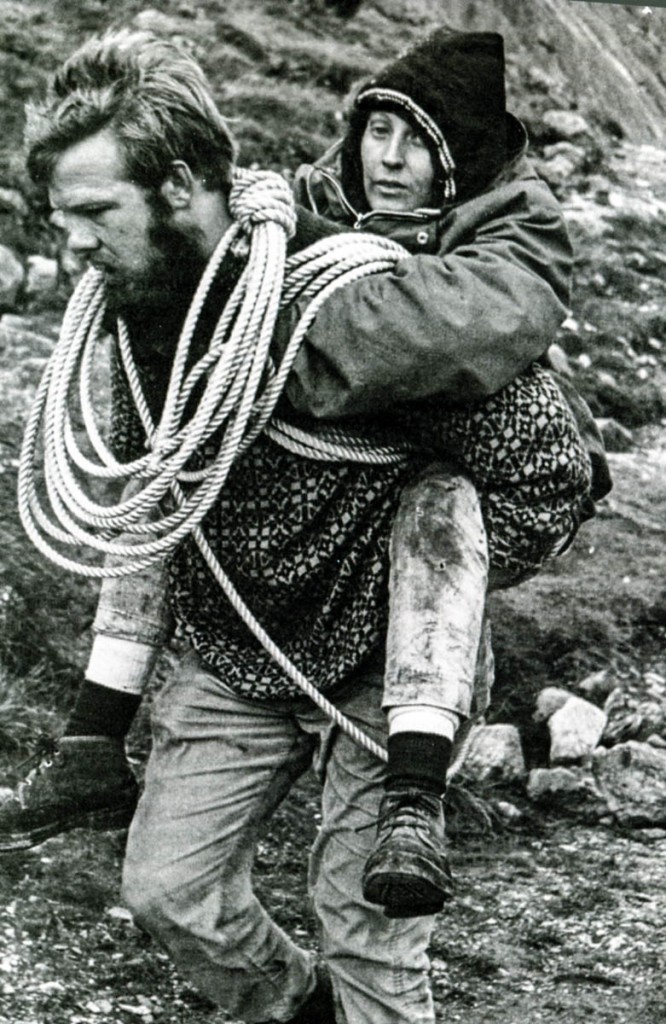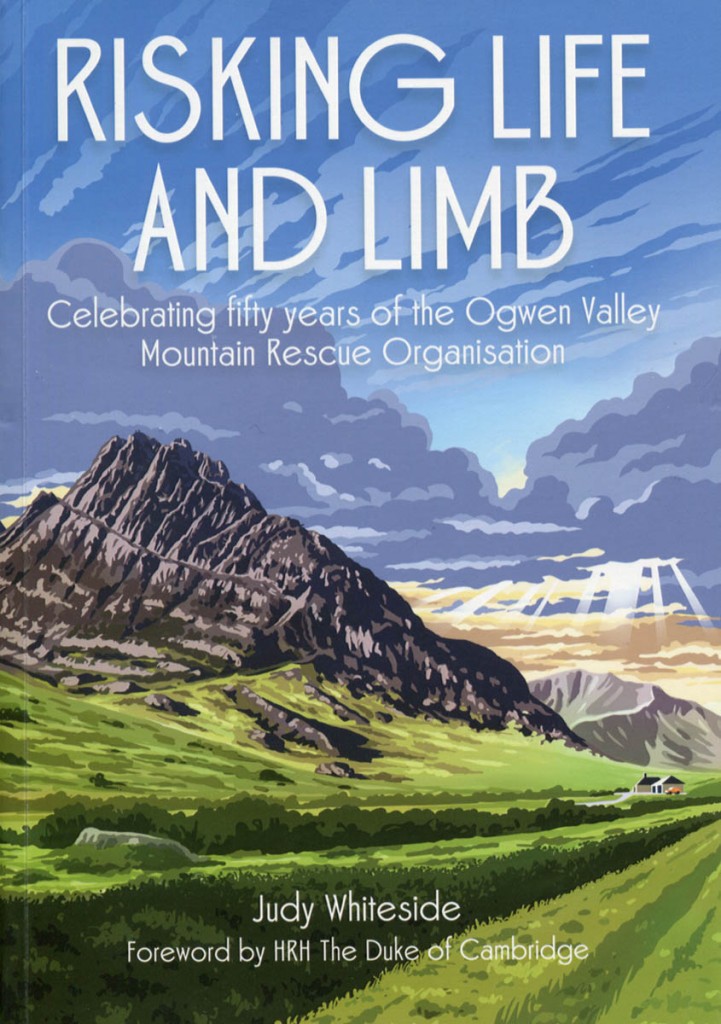
Rescue techniques have come on a little since this incident in 1968 in which Roger Jones is seen carrying Michelle Edwards to safety after 17 hours on a Tryfan ledge. Photo: OVMRO
This history of the north Wales team, written by Mountain Rescue magazine editor Judy Whiteside, was produced to mark the 50th anniversary of the Bryn Poeth-based volunteers.
It’s a mix of well researched archive-based material, interviews and some great archive pictures, plus some informative illustrations by George Manley.
The book features tragic and comic incidents, all of which have to be dealt with by the band of volunteers. It also details the wider development of mountain rescue in the UK has interspersed on its pages Oggi Snips, some humorous, some factual, to enlighten the reader.
The first recorded recreational fatality in the area was that of Philip Homer, whose body was found after an organised search on Moel Siabod in 1832 but the beginnings of any organised resources only came with the placing of first-aid and rescue equipment first at Gorphwysfa Hotel – now the Pen y Pass Youth Hostel – then at Ogwen Cottage and Pen y Gwryd.
Mountaineers largely carried out their own rescues of colleagues, using ‘borrowed’ items such as gates and finger posts to fashion makeshift stretchers and splints. But in 1932, committees from the Fell and Rock Climbing Club and Rucksack Club formed the Joint Stretcher Committee, leading to the development by Eustace Thomas of the first purpose-designed mountain stretcher.
Soon afterwards, mountain rescue posts – stretcher boxes – were established in the British mountains.
Among developments in north Wales were the efforts of consultant surgeon Wilson Hey, a mountaineer, to gain official approval for the use of morphine in rescues. In 1959, Ogwen Cottage was set up as a privately owned mountain instruction centre and would subsequently be designated an official mountain rescue post.
A disorganised rescue of John Glews, badly injured in a climbing accident, spurred the inaugural meeting of the Ogwen Valley Mountain Rescue Organisation in March 1965.
Judy Whiteside has delved into the team’s history for a plethora of interesting facts including the £5 ramshackle caravan used as its base that the council ordered to be removed and the sight of Tony Mason-Hornby’s Rolls-Royce limousine being used as a team bus and ambulance.
In 1990 the rescue team established its present headquarters at Bryn Poeth, and is unusual in having eight team leaders and a ‘sideways hierarchy’. It has strong international connections and has worked extensively with Canadian expert Kirk Mauthner in developing rope rescue techniques.
The risks run by mountain rescue volunteers are illustrated by the life-changing injuries team member Al Read suffered when a large boulder fell on him during a water rescue on the River Conwy.
The book also contains an account of the Ogwen Valley MRO’s involvement in the huge search for missing schoolgirl April Jones in and around Machynlleth – whose body has never been found, despite the conviction of Mark Bridger for the five-year-old’s murder.
Another taxing time for the team was the day of the Welsh 3,000s Race in 2009 when it had to field 10 simultaneous requests for help.
As the team moved into the 21st century, member Russ Hore, an IT specialist, developed the Sarloc system, which uses casualties’ smartphones to pinpoint their location. It’s a system now used not just across the UK, but internationally.
Other highlights of Risking Life and Limb are the 15½-hour stint spent on the Snowdon massif in freezing conditions by rescuer Nikki Wallis; the recollections of a certain Flight Lieutenant Wales during his three years flying rescue missions from nearby RAF Valley, and the subsequent transition to the civilian helicopter service under control of the Coastguard.
Anyone who ventures on to the hills of the UK and of Snowdonia in particular will appreciate the insight Judy Whiteside’s book gives into the development of the country’s volunteer mountain rescuers and the tragedies and triumphs of the men and women who operate the Ogwen Valley’s unstinting service on Tryfan, the Carneddau, the Glyderau and the other pointy bits of that corner of the national park.
Risking Life and Limb – Celebrating fifty years of the Ogwen Valley Mountain Rescue Organisation, is published by OVMRO and is available from the team’s website, priced £18.50 plus £1.50 post and packing.

John Howard
12 November 2016I stayed at Bryn Poeth on my first trip to Snowdonia in 1960 when it was owned by Dudley Stevens (Steve) who ran mountaineering courses.
It was very basic then with no electricity or sanitation and water from the stream ; it was also very dark,damp and cold. Cooking was done on Primus stoves....
Roger Sutton
16 November 2016The postage on my copy actually cost OVMRO £2.09 rather than £1.50, will make a donation to cover the difference. Be good if others check the postage value on their package.
You can donate on the OVMRO website under how to help.